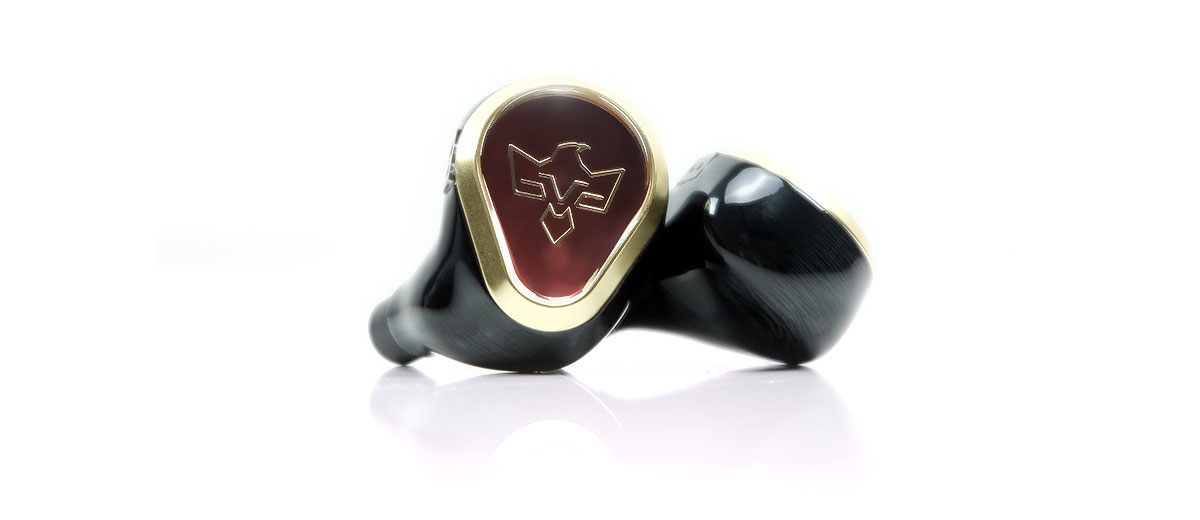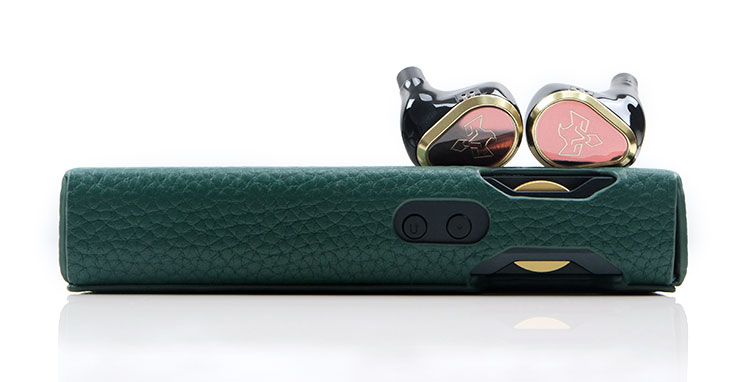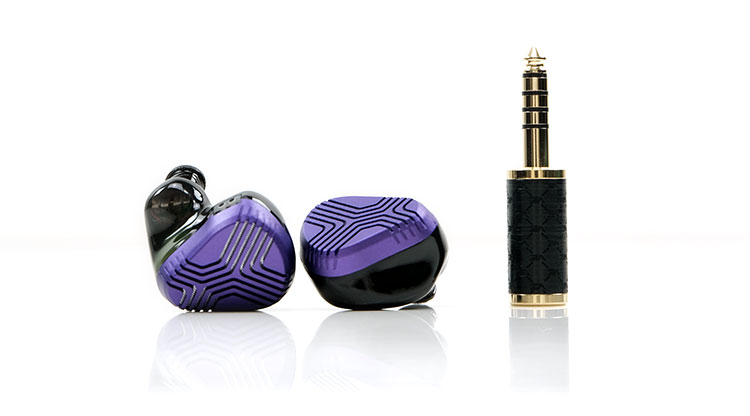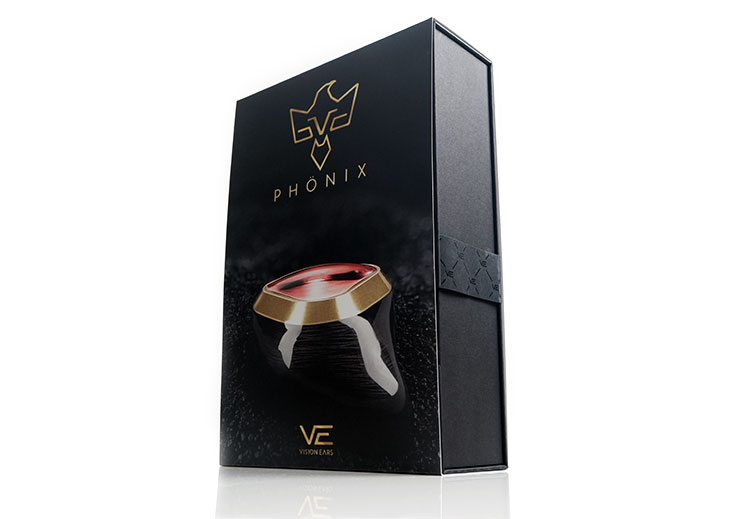Synergy
Efficiency
The Phönix is rated at 13Ω and 125dB SPL and as such, I would class this as a fairly sensitive and easy-to-driver in-ear monitor. You will not need much more than a low gain setting in most competent DAPs to drive the Phönix well.
Compared to the EXT it is miles easier to drive with the LP P6 Pro DAP set at a good 15-20 steps lower using its 4.4mm balanced output in a low gain mode.
Other competing IEMs such as the 64 Audio U18s and the Empire Ears Odin have a slightly more efficient performance compared to the EXT but still require a bit more juice than the Phönix to properly volume match.
Whilst I could detect some hiss from certain players such as the 4.4mm balanced output of the HiBy R8, overall, the Phönix delivered a very black background with some of the latest DAPs including the P6 Pro, FiiO’s M17, and the DX300 MAX. Older players such as the Sony 1z 4.4mm balanced out and dongles such as the LP W2 also delivered a very quiet noise floor.
Pairings
How a source shapes the thrust of the low end of the Phönix is almost as important as how it affects the general coloration. Resolution is also incredibly important for me for such a high-end monitor but the stock euphony of the Phönix is such that you can enjoy it still with a shade taken off the micro-detail.
Vocals Or Dynamic Range?
For example, the HiBy Rs6 sounds gorgeous with the Phönix vocals, offering a big and bold texture-rich delivery. However, it does not covey the same dynamic range or resolution as the DX300 MAX or the M17. Some of the treble information and air is a bit missing and the low end of the Phönix is a bit too smooth at times.
The M17 and DX300 MAX, however, will cool down the timbral warmth of the Phönix in favor of better spatial detail, improved treble extension, and in the case of the M17, a lot of additional power and bass energy.
Certainly, the M17 delivers more bass dynamics than with the RS6 or the DX300 MAX but the general euphony of the Phönix mids will fade to a more clinical tone.
The HiBy R8 fleshed out the bass well and was airier than the RS6 with better dynamic range and improved treble presence. However, the vocals sounded thinner for me with the Phönix and that is something I want to retain for any pairing.
Balance
The better balance was with the Lotoo PAW Gold Touch/Phönix pairing which had a more rounded tone to the midrange and higher pitching vocals with a hint of softness in its percussion strikes. It is not as airy or expansive as the big bricks from FiiO and iBasso but the bass/vocal balance felt more immediate and likable and more resolving also compared to the RS6.
The best balance was the P6 Pro pairing. You can get a stronger dynamic range, robust note texture, excellent detail, and a very life-like vocal response without it sounding as clinical or too warm. The Phönix sounded every inch of a high-end roller with this pairing.
Select Comparisons
Vision Ears EXT
€2650
The EXT was released almost at the same time as Phönix and in a similar fashion, it’s a bit of a rethink of a previous release, this time the Elysium. The price is somewhat lower though.
Technical
Inside, the configuration is very different with a hybrid mix of dynamic and electrostatic drivers as opposed to the all-BA mix inside the Phönix.
The precise configuration is a 9.2mm dynamic driver for the lows, a smaller HALC 2nd gen enclosed 6.2mm dynamic driver for the mids, and a 2nd gen transformer with two EST dual drivers for the highs. You are going to get a very dynamic mix of differing driver timbre from the EXT compared to the singular BA texture of the 13 BA driver Phönix.
The EXT is rated at 10Ω and 108.5db SPL and is much less sensitive compared to Phönix’s 13Ω and 125dB rating. Our real-world testing using a Luxury & Precision P6 Pro and an iBasso Dx300 MAX has the EXT had a much higher volume to match the SPL of the Phönix.
However, the Phönix is a little more sensitive to higher noise floors such as the HiBy R8 4.4mm balanced output which picked up a bit of hiss even in the low-gain mode which does not happen with the EXT.
Design
A hugely different aesthetic and form factor between these two. The EXT is more aggressive, futuristic, and graced with a CNC machine aluminum plate anodized with VE’s favorite purple. Its angular steep curving means a flusher fit in your ear and a very deep level of penetration into the ear canal.
The Phönix is boutique, jewelry-like with its glassy exterior, and more elegant and graceful in its finishing. Its contouring is softer, and the shell is more solid with that carbon fiber bloc but it also has bigger dimensions with a flatter underside.
Every time I look at the Phönix I am reminded of a Saville Row cufflink whereas with the EXT I feel a cyber vibe from a gaming setup.
The fitting is a different experience. The EXT is dimensionally smaller than the Phönix and you can feel that difference in your ear. Not that the Phönix is huge, more like a regular size if you ask me, but rather the EXT is so compact to allow that bendy nozzle to slide in really deep.
For the Phönix, the flatter underside and gentler curving on the nozzle mean the tips are required to do a bit more legwork to get a good seal. I could not work the AZLA tips at all on the EXT but on the Phönix they are easier to get on, isolate better than the SpinFits, and my preferred sound signature.
Finally, the Phönix stock 23AWG 4-wire silver-gold alloy with an OCC copper Litz cable is a setup on the performance of the 28AWG 8-wire SPC inside the EXT cable. Finishing is very similar on both though.
Performance
On a technical level, the EXT reaches deeper and taller with that dynamic driver for the lows and shimmery electrostatic drivers creating lots of air and space. The Phönix sounds more balanced and complex in the mids and it does stretch a bit wider for me also terms of stereo separation but definitely not as deep or as tall.
This creates a grander sound for the EXT but perhaps a simpler sound as well whereas the Phönix sounds more ‘filled in’ and detailed in terms of imaging and articulation through those mids.
The contrast in timbre for coloration is very obvious. You get a wonderful mix of dense dynamic driver textures on the lows and those pure-tone electrostatic highs from the EXT that deliver more contrast and a cleaner tone overall.
The mids are pure, and beautifully weighted but not as warm or as smooth sounding as the Phönix coloration.
In turn, the Phönix is punchier as opposed to weightier with less sub-bass presence but this dual-driver vented BA woofer design is very capable. I never once thought it was a shallow-sounding monitor.
Rather the emphasis is more on the 50-100Hz mid-bass marker with a slow slide into the lower mids that carries more warmth upwards. The treble is much more relaxed beyond 5k also so it is a more even harmonic euphonic tone compared to the EXT.
Mid timbre on the Phönix is smooth, rich, and more rounded with very little in the way of harmonic dissonance whereas the EXT keeps it much cleaner. Vocals can be more forward on the Phönix but I prefer the clarity of the EXT on lower male vocals given its better 1-2k bump and slight odd-harmonic uplift.
Empire Ears Odin
$3399
Technical
The Odin is Empire Ear’s flagship IEM with a price point not that far off the Phönix. However, it’s a very different proposition with a hybrid internal driver implementation consisting of dynamic, BA, and electrostatic as opposed to Phönix’s all-BA implementation.
The precise configuration is a dual W9+ 9mm dynamic subwoofer for the lows, 5 balanced armatures with 2 dual-driver units for the lower mids and the mids, and a single BA driver for the mid-highs. For the highs, it uses 4 2nd gen Sonion electrostatic drivers in a dual-driver pack design.
Both use fairly complex crossovers with a 5-way passive crossover for Phönix and an even more ambitious 8-way synX crossover for the Odin. Beyond that, the Odin is also coated internally with Empire Ears’ A.R.C technology which is an anti-resonance compound to lower potential resonance from the drivers.
The Odin is rated at a very low 3Ω but is less efficient at 108dB SPL compared to the 125dB of the Phönix. In truth, most electrostatic hybrids tend to need more juice and the Odin is no different in that regard with our P6 Pro and DX300 MAX being set at a slightly higher volume than the Phönix.
However, the Odin is less hiss sensitive on the likes of the HiBy R8 4.4mm balanced output. For most other modern DAPs such as M17, I didn’t find hiss to be an issue on either monitor.
Design
The Odin design has a punkier feel to its aesthetic with bigger dimensions also. I do like the Odin Bifrost plate, it stands out with plenty of color pop and looks very unique. However, the Phönix carbon fiber shell, sapphire glass, and red inlay material and finish do look more exotic and refined. The gold-accented ring just adds to that jewelry type of effect.
The Odin contouring is more aggressive though, especially on the underside and despite its larger size, it is the lighter of the two monitors.
With the SpinFit tips, there is a little bit of manipulation required to get the Phönix just right in the ear for isolation purposes whereas the Final E tips and the Odin fit right away. The Azla tips on the Phönix or me get a lot closer to that one-time perfect fit. With a venting port, however, Odin isolation levels are just a tiny bit behind the non-vented Phönix performance.
The cables on both are fantastic and clearly show a lot of investment with 3rd parties to get the right type of matching cable.
The Stormbreaker is a spin on PW Audio’s kilo bucks 1960s 2-wire and it is lighter and thinner using a smaller gauge but with a 2-wire, 4-conductor (2 positives, 2 negatives), OCC copper Litz geometry. The Phönix cable is also a 4-wire but with silver-gold alloy with an OCC copper Litz and a larger 23AWG gauge.
Performance
The clarity kings versus a bit of high-class soul and character, pick your poison. The Odin, like the EXT, reaches deeper and taller than the Phönix with a stronger bass response and extended highs that bring more of a cooler timbre to the mids. The Odin is all about excitement or energy mixed with dynamics and clarity.
The Phönix excels in the mids, bringing a greater degree of richness, a smoother upper mids, and generally a more relaxing vocal. This is all about balanced and involved listening.
Certainly, the Phönix treble is softer, less emphasized giving way to a level of mids timbral euphony built for forgiveness. The detail is very much there, possibly just as much as the Odin but it is not done in a high-energy high-contrast manner.
A big difference is from the bass-to-mids transition with the Odin showing more bass-to-mids separation with a faster drop from 50Hz onwards into a more dipper lower-mids up to 1k. The sub-bass is much more elevated so the rumble is very distinct and powerful.
The Phönix bass plateau is more mid-bass so punchier but less low-end rumble. The dip is much less emphasized with more upper bass to lower-mids warmth giving it that more rounded liquid-like tone and improved lower-mids body.
The Odin’s famed upper-mids push is stronger than the Phönix so whilst the VE tuning does place vocals forward it is not as front and center for higher-pitching vocals on the Odin. You get a trade then between clean and clear and warm or natural for both vocal performances.
64 Audio U18s
$2999
I suspect this comparison will have greater appeal to BA fans looking at alternatives. The U18s is not quite the flagship of the 64 Audio range with the higher-priced Fourte holding that title.
Technical
Nevertheless, the U18s price is relatively close to the Phönix and is packed with no less than 18 BA drivers per side as opposed to 13 inside the VE creation. The precise grouping is 8 drivers for the lows, 8 for the mids, 1 for the mid-highs, and a tia driver, (tubeless), for the highs.
The Phönix uses vented dual-driver BA modules for the lows, non-vented for the mids that are split between the low-mids and mid/highs, and an additional spout-free super tweeter for the ultra-highs, (headroom and air) in an inlay design.
Crossovers are different also with the U18s using an integrated 4-way electronic passive crossover and the Phönix using a passive 5-way crossover.
64 Audio does throw in some additional tech including their patented apex filtering solutions for sound tuning and air pressure management as well as LID for a flat impedance response.
The U18s is rated at 8Ω and a less efficient 106dB SPL on paper compared to the 125dB rated Phönix. That pretty much rang true with our test DAPs, the HiBy R8 and P6 Pro. Both required a bit more volume to get the U18s singing properly compared to the Phönix.
Design
The U18s has a more understated but still intricate and attractive design. It is perhaps one of my favorites for product photography work with its no reflective matte black visual and lattice-type natural formation faceplate.
It is quite a contrast to the jewelry vibe of the Phönix and I dare say much of that is related to the target customer with studio pros being aimed at the U18s. Pros who might balk at the refined looks of the Phönix during a concert night. You could argue the Phönix is for their night off, something to show off to the mates or partner over a beer.
The materials on the Phönix are certainly more exotic and braver with that carbon fiber shell. It does allow it to remain lighter than the aluminum materials used for the slightly larger or deeper U18s.
Using aluminum also means the shape of the U18s places a lot more emphasis on the tips nailing the isolation. Aluminum shells can often be difficult to fit just right and the U18s do better than most just not as good as the Phönix’s isolation performance with their respective stock tips.
The U18s stock cable is 64 Audio’s Premium 8-Braid Silver Cable and it’s quite good in terms of decent low resistance and dynamic range but it’s a step behind the larger 23AWG gauge 4-wire silver-gold alloy with an OCC copper Litz cable that comes with the Phönix. The finishing is also much better on the VE stock cable.
Performance
I have always considered the U18s to be a relatively smooth-sounding monitor but compared to the Phönix’s richer euphony I would classify it as comparatively neutral in both weight and imaging.
The U18s is also very much a reference-type sound, albeit to the smoother side for the U18s. It keeps you somewhat more of a distance from a perceptibly wider and taller soundstage compared to the Phönix’ which is more upfront, and deeper or more powerful in terms of immediate impact, especially vocal and bass imaging.
You do have to go with the m20 module to get the U18s closer to the verve of the Phönix’s low-end. Both the m15 and the mX modules give the U18s a much lighter and less impactful tuning but still very balanced IMHO.
The U18s does have a more pronounced cut from 100hz up to 1k whereas the Phönix is more gradual and less prolonged in its dip meaning instruments are warmer, beefier, and denser sounding.
I also suspect 64 Audio has used slightly smaller or enclosed BA drivers for the low-end because while the extension is as good as the Phönix, the weight is not as impressive nor the body is as fulsome.
That lighter touch also extends through to the U18s mids where instrumental and vocal timbre is very pure and smooth but also lighter given the reduced fundamental and reduced mid-to-upper bass warmth.
Some of that more neutral imaging I spoke about takes away from the vocal immediateness on the U18s but you can pick out extreme staging spatial cues on the U18s a little easier. There is a little odd-harmonic uptick and improved air or presence from the U18s tia driver that is not as emphasized on the extreme highs of the Phönix.
Our Verdict
The Vision Ears Phönix is a pricey but beautifully designed high-end monitor built for blissful and stress-free listening. Its coherent timbre has an inviting and intoxicating blend of smooth-sounding mids and gorgeously rich vocals backed up by a punchy low-end performance when called upon.
It feels wonderfully balanced right across the frequency range and could well stand in as the yin to the rumbling high-energy yang of the EXT.
Certainly, these are the two best monitors currently on offer right now from Vision Ears. And the best part is, (I hope), that the Phönix will not be a limited edition quite in the same manner as the fabled ERLKöNIG.
Vision Ears Phönix Specifications
- 5-way crossover
- 4 x BA drivers for bass
- 4 x BA drivers for mids
- 4 x BA drivers for highs
- 1 x BA super tweeter
- Impedance: 13Ω @ 1KHz
- Sensitivity 1mW: 125 dB SPL @ 1KHz (100mV)







